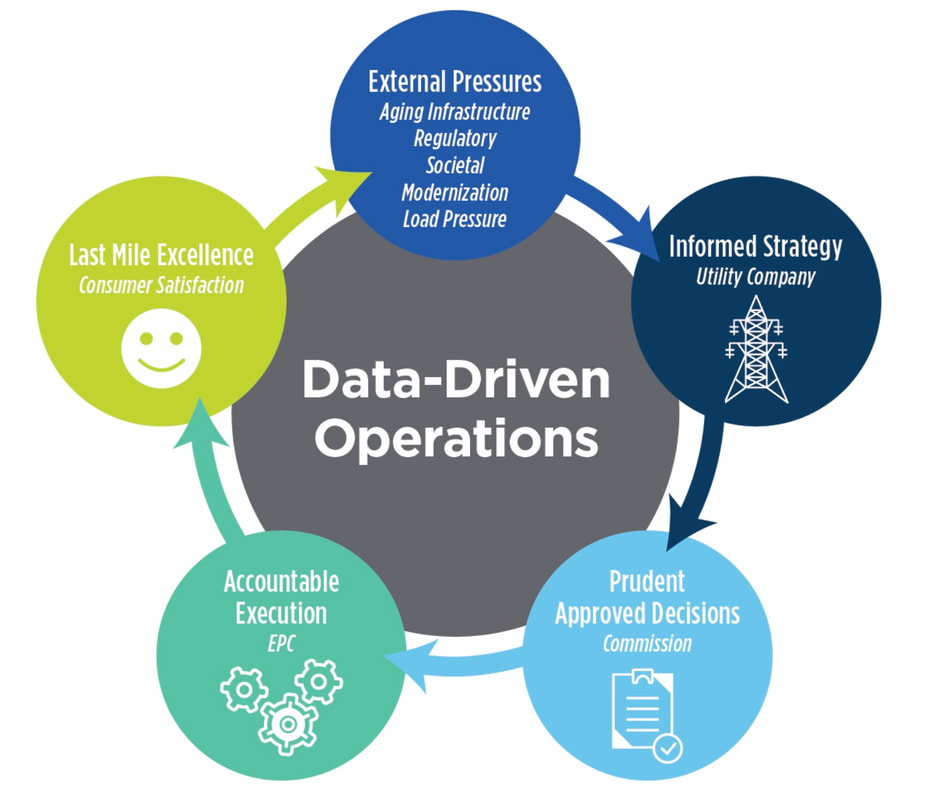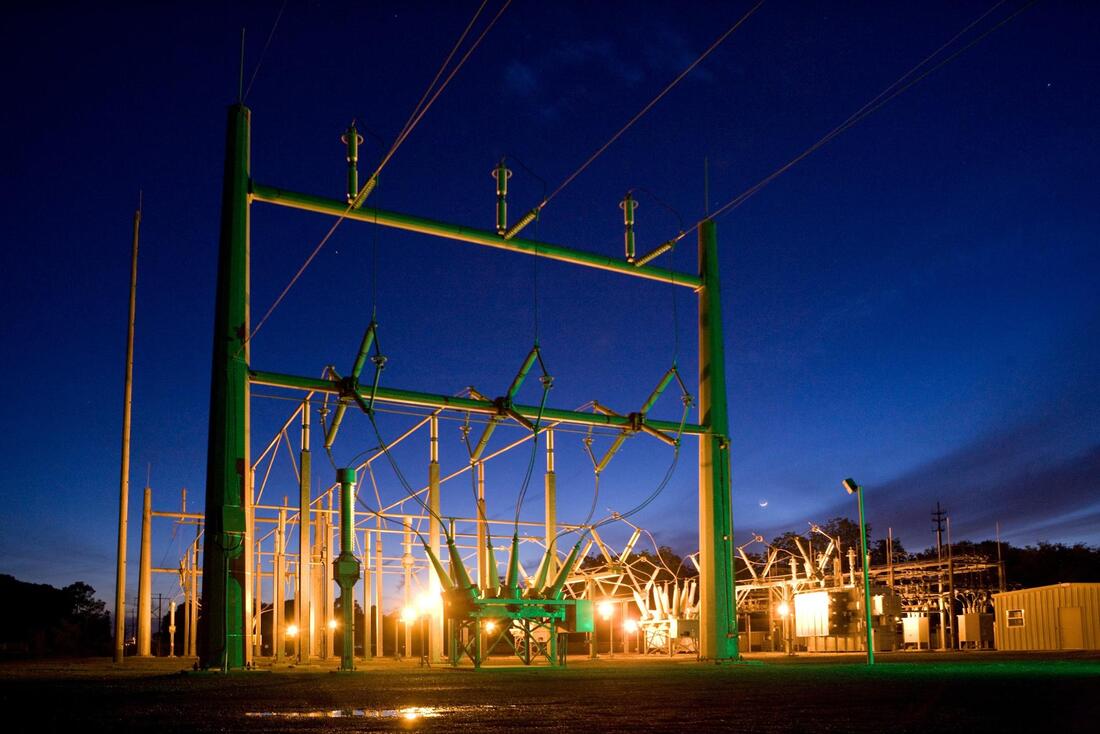Make It Strong
Most would agree it would be unwise to put a new roof on a house whose foundation is collapsing. Thus, any grid modernization program must start by making sure the physical infrastructure is sound
Most would agree it would be unwise to put a new roof on a house whose foundation is collapsing. Thus, any grid modernization program must start by making sure the physical infrastructure is sound
|
Modernization programs should move beyond concerns of “overbuilding” and critically explore approaches and options that will result in a grid that is built to last. New materials — like concrete or steel poles, insulated overhead conductors and much more — must be incorporated in new design standards when they make sense for the service territory. Physical assets such as poles, conductors, wires and transformers must be robust enough to withstand stress, continual use, thermal loads and all forms of severe weather.
Substations should be designed with robust and modular components that are not prone to failure. Modularized substations with components that can be bulk-procured is a proven, high-value way to simplify operations, reduce costs and limit downtime. Modular substations featuring fewer custom components allow for faster repair and less inventory. Consistent asset designs mean more rapid deployment using in-stock assets, the ability to increase power where and when it’s needed, and less installation delay. With fewer parts and tools, maintenance is simplified and training is easier. |
Rethinking generation locations and nighttime cooling periods also should be considered. Equally important are design standards that make it easy for line crews and even technicians to remotely perform future maintenance, avoiding outages and even brief interruptions.
In addition to structural quality improvements, the modern grid must be sized to meet unforeseen future demand. Today’s power needs and potential generation opportunities reside at every point on the circuit and the grid must be capable of handling it.
Community solar projects, commercial rooftop arrays, distributed microgrids and energy projects, and even remote farms and properties at the end of the line should be viewed as assets to the overall grid and accommodated in planning. The ability to carry the same amount of power at the end of the circuit as at the substation needs to be a design principle.
Greater penetration of EVs must also be part of the planning forecast for distribution systems. One EV can double the total consumption of residential energy. Thus, 10% of households charging EVs would be the equivalent of growing the residential customer base by 7%.
In addition to structural quality improvements, the modern grid must be sized to meet unforeseen future demand. Today’s power needs and potential generation opportunities reside at every point on the circuit and the grid must be capable of handling it.
Community solar projects, commercial rooftop arrays, distributed microgrids and energy projects, and even remote farms and properties at the end of the line should be viewed as assets to the overall grid and accommodated in planning. The ability to carry the same amount of power at the end of the circuit as at the substation needs to be a design principle.
Greater penetration of EVs must also be part of the planning forecast for distribution systems. One EV can double the total consumption of residential energy. Thus, 10% of households charging EVs would be the equivalent of growing the residential customer base by 7%.
|
Finally, utilities should end the “break/fix” mentality once and for all. In other words, operations and maintenance (O&M) programs must be structured to achieve the greatest long-term value instead of minimizing short-term costs. O&M programs focusing only on fixing the worst problems with the least-cost materials will not position utilities to meet future expectations. Effective grid modernization must build strength by implementing a larger, long-term plan incorporating better materials. This will achieve the greatest business impact.
|
One EV can double
the total consumption of residential energy. |
Make It Smart
Connected consumers rely on intelligent devices and now expect such capabilities from service providers. With technology advances and cost reductions in digitization, miniaturization, wireless and fiber optics, software — and nearly unfathomable speeds in computer processing — there is no reason not to deploy advanced sensor capabilities and a host of related technologies on the grid.
Modernization efforts offer an excellent opportunity to take advantage of new technology. Grid modernization must go well beyond automated metering. Building it smarter affords utilities the opportunity to fundamentally improve operations through outage tracking, analysis, reporting and utility response planning.
Advanced metering infrastructure (AMI) serves as a backbone of the distribution system. AMI is the energy measurement and collection system, including on-site customer meters, designed to take full advantage of the complete smart communications system.
This two-way communication capability allows for remote measurement of electricity use; service connection and disconnection; tampering detection; outage location, cause and isolation; voltage monitoring; and more. Utility time-based rate programs, peak demand incentives and energy consumption monitoring also are enabled.
Using real operational metering means dynamic tap changes can be made to accommodate more generation or prevent low voltage. It also means that capacitor banks can be remotely turned on or off so that inverters on solar generation units can be tuned to provide the right amount of reactive power. All this reduces line losses and provides higher-quality power.
Connected consumers rely on intelligent devices and now expect such capabilities from service providers. With technology advances and cost reductions in digitization, miniaturization, wireless and fiber optics, software — and nearly unfathomable speeds in computer processing — there is no reason not to deploy advanced sensor capabilities and a host of related technologies on the grid.
Modernization efforts offer an excellent opportunity to take advantage of new technology. Grid modernization must go well beyond automated metering. Building it smarter affords utilities the opportunity to fundamentally improve operations through outage tracking, analysis, reporting and utility response planning.
Advanced metering infrastructure (AMI) serves as a backbone of the distribution system. AMI is the energy measurement and collection system, including on-site customer meters, designed to take full advantage of the complete smart communications system.
This two-way communication capability allows for remote measurement of electricity use; service connection and disconnection; tampering detection; outage location, cause and isolation; voltage monitoring; and more. Utility time-based rate programs, peak demand incentives and energy consumption monitoring also are enabled.
Using real operational metering means dynamic tap changes can be made to accommodate more generation or prevent low voltage. It also means that capacitor banks can be remotely turned on or off so that inverters on solar generation units can be tuned to provide the right amount of reactive power. All this reduces line losses and provides higher-quality power.
Getting Smart Architecture in Place
Modern grid planning must incorporate a robust, reliable and efficient architecture to handle new loads and distributed generation at customer sites. Distribution automation (DA) is a crucial component because it leverages AMI and other distribution sensors like remote fault indicators or sensors in reclosers. Intelligent planning of the location of DA assets allows them to be at the right locations without putting in more than is necessary. Careful evaluation of placement of automatic circuit reclosers (ACRs), feeder switches and loop schemes should occur for all grid upgrades.
Modern grid planning must incorporate a robust, reliable and efficient architecture to handle new loads and distributed generation at customer sites. Distribution automation (DA) is a crucial component because it leverages AMI and other distribution sensors like remote fault indicators or sensors in reclosers. Intelligent planning of the location of DA assets allows them to be at the right locations without putting in more than is necessary. Careful evaluation of placement of automatic circuit reclosers (ACRs), feeder switches and loop schemes should occur for all grid upgrades.
|
Substation automation (SA) collects and analyzes significant amounts of component and control data to further enhance reliability and real-time response to events. By going well beyond traditional SCADA systems, SA programs can deliver advanced capabilities and improve operations and maintenance. Dynamic voltage control must be available on each phase to minimize imbalance and maximize the ability to collect energy from distributed generation sources. Because the balance changes between day and night, simply moving transformers from phase to phase to balance the circuit is not possible. Dynamic voltage control on each phase must be driven by SA.
Smart SA planning addresses a range of considerations, including transitioning, to triple singles in a phase-by-phase approach. Protecting power and increasing efficiency comes from the ability to isolate any phase problems while keeping power flowing. |
Advanced communications networks may be one of the most essential pieces of the grid, given the need to manage and control grid scheduling, prioritizing data sent and actions needed. For grid modernization planning, smart communications can be designed for transmission, substations and in the distribution network to the meter and beyond the meter at homes and offices.
Networks capture and transfer the data and insight needed to deliver long-term operational refinement, thereby enabling network predictability and continuous improvement for utilities and customers. Considerable analysis capability can be installed in each of these zones so that only the critical data must be brought back to the central office.
While they are installed in the operations center, DA and SA are mostly useless without the system’s ability to analyze the data and make it available to operators. Still, operators and planners should avoid getting swept up in the almost infinite capabilities that may be presented by this wealth of data. Instead, zero in on the simplest and easiest applications that quickly add value and increase grid efficiency. Programs and elements must work together to help transform the operation, interaction and management of grid assets.
Networks capture and transfer the data and insight needed to deliver long-term operational refinement, thereby enabling network predictability and continuous improvement for utilities and customers. Considerable analysis capability can be installed in each of these zones so that only the critical data must be brought back to the central office.
While they are installed in the operations center, DA and SA are mostly useless without the system’s ability to analyze the data and make it available to operators. Still, operators and planners should avoid getting swept up in the almost infinite capabilities that may be presented by this wealth of data. Instead, zero in on the simplest and easiest applications that quickly add value and increase grid efficiency. Programs and elements must work together to help transform the operation, interaction and management of grid assets.
Make It Sustainable
Modern grid sustainability encompasses both environmental responsibility and improved O&M. Simplifying and reducing grid complexity makes the grid easier to maintain and sustain. Standardizing supplies and components results in fewer parts to purchase, a lower quantity of needed supplies and greater probability that supplies will be on hand.
Simpler, standardized substations and systems also make training easier with less reliance on the “field knowledge” of experienced line crews and other personnel.
A stronger, smarter grid also enables more environmentally responsible operations, including EVs, PV, storage and other renewables on the grid. Likewise, in selecting components, consideration is given to choosing equipment that is environmentally benign and highly recyclable.
Learn, Adapt, Optimize
Maintaining a strong, smart grid means learning from operations and customer usage to optimize efficiency and performance.
Thanks to insights yielded from data analysis, procedures and strategies can be adjusted over time to manage usage patterns and reduce failure rates. Smart components encourage customers to take responsibility for energy use. Using this analysis can also define customer programs to meet their needs and desires while holding prices at a reasonable level.
Modern grid sustainability encompasses both environmental responsibility and improved O&M. Simplifying and reducing grid complexity makes the grid easier to maintain and sustain. Standardizing supplies and components results in fewer parts to purchase, a lower quantity of needed supplies and greater probability that supplies will be on hand.
Simpler, standardized substations and systems also make training easier with less reliance on the “field knowledge” of experienced line crews and other personnel.
A stronger, smarter grid also enables more environmentally responsible operations, including EVs, PV, storage and other renewables on the grid. Likewise, in selecting components, consideration is given to choosing equipment that is environmentally benign and highly recyclable.
Learn, Adapt, Optimize
Maintaining a strong, smart grid means learning from operations and customer usage to optimize efficiency and performance.
Thanks to insights yielded from data analysis, procedures and strategies can be adjusted over time to manage usage patterns and reduce failure rates. Smart components encourage customers to take responsibility for energy use. Using this analysis can also define customer programs to meet their needs and desires while holding prices at a reasonable level.
|
Many external assets — such as geospatial data, Google Earth maps and drones — can complement grid improvements and provide utilities increased understanding about outages and operational threats. Sensor data, coupled with satellite and terrain imagery, offers a way to proactively manage vegetation and related events such as downed trees, and schedule maintenance or repair faster and more accurately.
|
Maps and drones can provide utilities increased understanding about outages and operational threats.
|
Greater grid insight and data tracking can bring attention to load changes and growth trends in communities. Planning for needed substation modifications or capacity upgrades is more efficient and can be budgeted accordingly. With insight into local commercial demand, utilities can proactively plan to support new income-generating opportunities.
A modern grid with the ability to sustain long-term technology advancements and support increased adoption of renewable energy sources allows for needed hosting capacity. More EVs, faster-charging battery storage, and highly flexible demand-response programs will help support the communities of the future.
Conclusion
Quick fixes and tactical solutions won’t deliver the modern grid that consumers need. By holistically evaluating a utility’s entire system — from circuit data to asset performance, power flow and failure risk to design and operating standards — grid planning becomes comprehensive in scope while modular in design and implementation. Effective modernization planning aims to make a strong, smart and sustainable grid that customers can count on for reliability and resiliency for generations to come.
A modern grid with the ability to sustain long-term technology advancements and support increased adoption of renewable energy sources allows for needed hosting capacity. More EVs, faster-charging battery storage, and highly flexible demand-response programs will help support the communities of the future.
Conclusion
Quick fixes and tactical solutions won’t deliver the modern grid that consumers need. By holistically evaluating a utility’s entire system — from circuit data to asset performance, power flow and failure risk to design and operating standards — grid planning becomes comprehensive in scope while modular in design and implementation. Effective modernization planning aims to make a strong, smart and sustainable grid that customers can count on for reliability and resiliency for generations to come.
Reprinted with permission. Read the original article.




